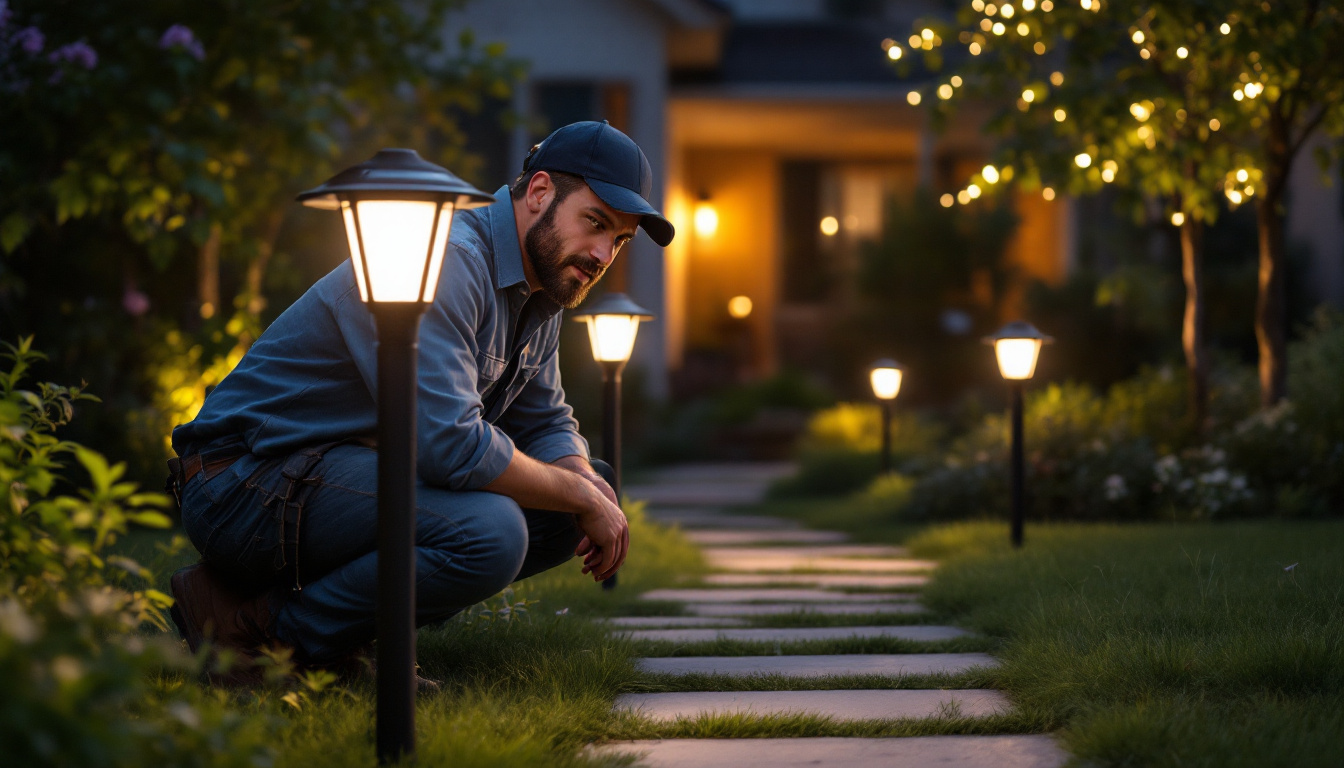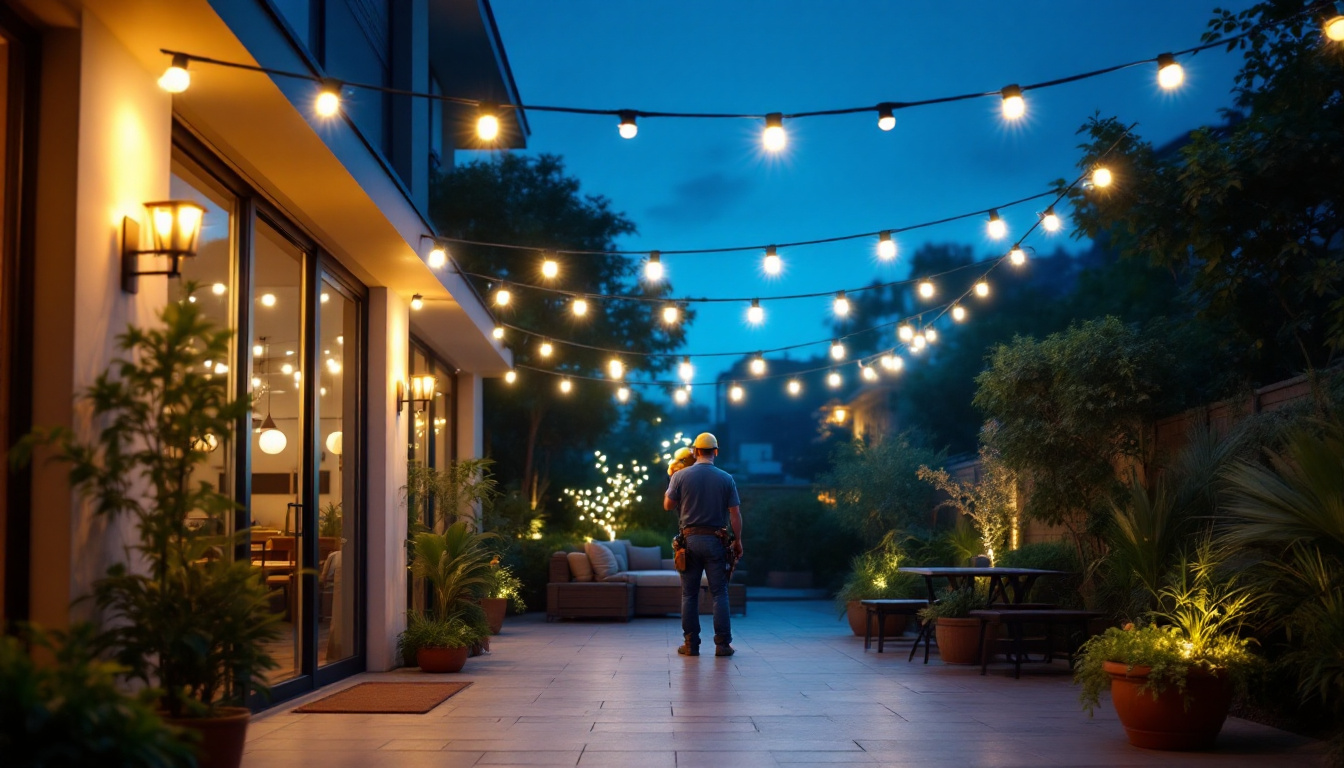
Backyard solar lamps have gained immense popularity in recent years, offering an eco-friendly and cost-effective solution for outdoor lighting. These lamps harness solar energy to illuminate gardens, pathways, and patios, providing both functionality and aesthetic appeal. For lighting contractors, understanding the intricacies of solar lamp installation and maintenance is crucial to ensure client satisfaction and avoid common pitfalls.
As the demand for sustainable lighting solutions grows, contractors must equip themselves with the knowledge and skills necessary to navigate the unique challenges associated with solar technology. This article delves into the common issues faced during the installation of backyard solar lamps and offers practical strategies for lighting contractors to mitigate these challenges.
One of the primary advantages of backyard solar lamps is their ability to operate independently of the electrical grid, making them an ideal choice for remote areas or locations where traditional wiring would be impractical or costly. These lamps typically come equipped with LED lights, which are not only energy-efficient but also have a longer lifespan compared to conventional bulbs. Additionally, many models feature adjustable brightness settings and motion sensors, allowing homeowners to customize their outdoor lighting experience while enhancing security. Understanding the specifications and features of various solar lamp models can empower contractors to make informed recommendations that align with their clients’ needs.
Moreover, the installation process for solar lamps often requires careful consideration of site conditions. Factors such as sunlight exposure, seasonal variations, and local weather patterns can significantly impact the performance of solar lamps. For instance, areas with heavy tree cover may require strategic placement to maximize sun exposure, while regions with harsh winters may necessitate the use of more robust, weather-resistant models. By conducting a thorough site assessment and discussing these factors with clients, contractors can ensure that the chosen solar lamps will provide optimal performance and longevity, ultimately leading to increased customer satisfaction and repeat business.
Before diving into installation practices, it’s essential for lighting contractors to have a solid grasp of how solar lamps operate. These lamps typically consist of a solar panel, a rechargeable battery, an LED light source, and a control circuit. The solar panel collects sunlight during the day, converting it into electrical energy, which is then stored in the battery for use at night.
Each component plays a vital role in the overall functionality of the solar lamp. The solar panel’s efficiency is influenced by its size and the quality of materials used. A larger panel can capture more sunlight, while high-quality materials ensure durability and longevity.
The rechargeable battery is equally important, as it determines how long the lamp will operate after sunset. Lithium-ion batteries, for example, offer better performance compared to traditional lead-acid batteries, providing longer life cycles and faster charging times.
Solar lamps come in various designs, each suited for different applications. Pathway lights, floodlights, and decorative lanterns are just a few examples. Understanding the specific needs of a project will help contractors recommend the most appropriate type of solar lamp to their clients.
For instance, pathway lights are ideal for illuminating walkways, while floodlights can provide broader coverage for larger areas. Decorative lanterns, on the other hand, can enhance the aesthetic appeal of outdoor spaces, making them a popular choice for gardens and patios.
While solar lamps are relatively easy to install, several challenges can arise during the process. Awareness of these potential issues can help contractors proactively address them, ensuring a smooth installation experience.
One of the first steps in installing solar lamps is conducting a thorough site assessment. Factors such as shading from trees or buildings can significantly impact the performance of solar panels. Lighting contractors must evaluate the site to determine the best locations for lamp installation, ensuring they receive adequate sunlight throughout the day.
Additionally, the orientation of the solar panels should be considered. Ideally, they should face south to maximize sun exposure. If the site has limited sunlight, contractors may need to discuss alternative solutions with their clients, such as supplementing solar lamps with traditional lighting or using higher-capacity solar lamps.
While solar lamps are designed to operate independently of traditional electrical systems, mechanical and electrical issues can still arise. For instance, improper connections or faulty components can lead to malfunctioning lamps. Contractors should ensure that all connections are secure and that the components are compatible with each other.
Regular maintenance is also crucial for preventing electrical issues. Dust, debris, and weather conditions can affect the performance of solar panels and batteries. Contractors should advise clients on the importance of cleaning the solar panels periodically and checking the batteries for signs of wear or damage.
To avoid common issues and ensure successful installations, lighting contractors should adhere to best practices throughout the process. These practices not only enhance the performance of solar lamps but also improve client satisfaction.
When installing solar lamps, proper placement and spacing are essential. Lamps should be positioned to provide optimal illumination without creating dark spots. A general guideline is to space pathway lights about 6 to 8 feet apart, depending on the brightness of the lamps and the desired level of illumination.
Moreover, contractors should consider the height of the lamps. Taller lamps can cast light over a wider area, while shorter lamps may create a more intimate ambiance. Understanding the specific lighting needs of the space will guide contractors in making informed decisions about placement and height.
Effective communication with clients is paramount in the installation process. Lighting contractors should educate clients about the functionality of solar lamps, including their limitations and maintenance requirements. This transparency helps set realistic expectations and fosters trust between contractors and clients.
Contractors should also provide guidance on how to operate the lamps effectively. For instance, clients should be informed about the importance of keeping the solar panels clean and ensuring that no obstructions block sunlight. By empowering clients with knowledge, contractors can enhance the overall experience and satisfaction with the solar lighting system.
Even after a successful installation, ongoing maintenance is essential to ensure the longevity and performance of solar lamps. Lighting contractors should establish a maintenance plan and offer troubleshooting tips to clients.
Contractors should recommend routine maintenance checks to clients, ideally at the beginning of each season. During these checks, clients can clean the solar panels, inspect the batteries, and ensure that the lamps are functioning correctly. This proactive approach can prevent minor issues from escalating into major problems.
Additionally, contractors can offer maintenance services to clients, providing peace of mind and ensuring that the solar lamps continue to operate efficiently. Regular maintenance not only prolongs the life of the lamps but also enhances the overall lighting experience for clients.
In the event of malfunctioning solar lamps, contractors should be prepared to troubleshoot common issues. For instance, if a lamp is not turning on, it may be due to a dirty solar panel, a drained battery, or a faulty connection. Contractors should guide clients through a systematic troubleshooting process to identify and resolve the issue.
Providing clients with a troubleshooting guide can also empower them to address minor issues independently. This resource can include steps for cleaning solar panels, checking battery levels, and inspecting connections, ensuring that clients feel supported even after the installation is complete.
The solar lighting industry is continuously evolving, with advancements in technology and design shaping the future of backyard solar lamps. Lighting contractors should stay informed about these trends to remain competitive and offer the best solutions to their clients.
One of the most exciting trends in solar lighting is the integration of smart technology. Smart solar lamps can be controlled remotely via smartphone apps, allowing users to adjust brightness levels, set timers, and monitor energy consumption. This level of control enhances user experience and promotes energy efficiency.
Contractors should consider incorporating smart solar lamps into their offerings, as clients increasingly seek innovative and convenient solutions for outdoor lighting. Understanding the features and benefits of smart technology will enable contractors to educate clients effectively and recommend the best products for their needs.
Battery technology is also advancing, with newer models offering improved performance and longer life cycles. Lithium iron phosphate (LiFePO4) batteries, for example, provide higher energy density and greater safety compared to traditional battery types. Contractors should stay updated on the latest battery technologies to recommend the best options for their clients.
By understanding the benefits of enhanced battery technology, contractors can ensure that solar lamps operate efficiently, even in challenging weather conditions. This knowledge can also help contractors address client concerns about battery performance and longevity.
Backyard solar lamps present a fantastic opportunity for lighting contractors to offer sustainable and innovative lighting solutions. By understanding the technology, addressing common installation challenges, and adhering to best practices, contractors can avoid issues and ensure client satisfaction.
As the industry continues to evolve, staying informed about trends and advancements will further enhance the ability of contractors to provide exceptional service. With the right knowledge and skills, lighting contractors can successfully navigate the world of solar lighting, delivering beautiful and functional outdoor spaces for their clients.
Ready to elevate your lighting projects with the most sustainable and innovative solutions? At LumenWholesale, we provide lighting contractors like you with top-quality, spec-grade backyard solar lamps and more, all at unbeatable wholesale prices. Say goodbye to local distributor markups and hello to our extensive selection that meets the highest industry standards. Plus, enjoy the convenience of free shipping on bulk orders, ensuring you get premium lighting at the best value — without hidden fees or compromises. Don’t miss out on the perfect blend of quality, affordability, and convenience. Visit LumenWholesale today for Wholesale Lighting at the Best Value and light up your client’s outdoor spaces with confidence.

Discover the ultimate guide to canopy lights LED for lighting contractors.

Discover how LED store lighting can revolutionize the way lighting contractors operate, offering significant savings in both time and money.

Discover the science behind grow lights and their impact on plant growth, tailored specifically for lighting contractors.

Unlock the secrets of art track lighting with our comprehensive guide tailored for lighting contractors.